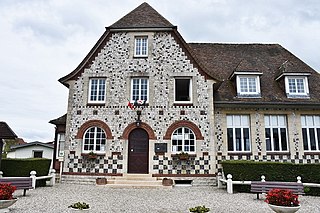Doudeville | |
|---|---|
 The château de Galleville | |
| Coordinates: 49°43′16″N0°46′59″E / 49.7210°N 0.7830°E | |
| Country | France |
| Region | Normandy |
| Department | Seine-Maritime |
| Arrondissement | Rouen |
| Canton | Yvetot |
| Intercommunality | CC Plateau de Caux |
| Government | |
| • Mayor (2020–2026) | Daniel Durécu [1] |
| Area 1 | 14.51 km2 (5.60 sq mi) |
| Population (2021) [2] | 2,460 |
| • Density | 170/km2 (440/sq mi) |
| Time zone | UTC+01:00 (CET) |
| • Summer (DST) | UTC+02:00 (CEST) |
| INSEE/Postal code | 76219 /76560 |
| Elevation | 85–156 m (279–512 ft) (avg. 120 m or 390 ft) |
| 1 French Land Register data, which excludes lakes, ponds, glaciers > 1 km2 (0.386 sq mi or 247 acres) and river estuaries. | |
Doudeville (French pronunciation: [dudvil] ) is a commune in the Seine-Maritime department in the Normandy region in northern France.


















